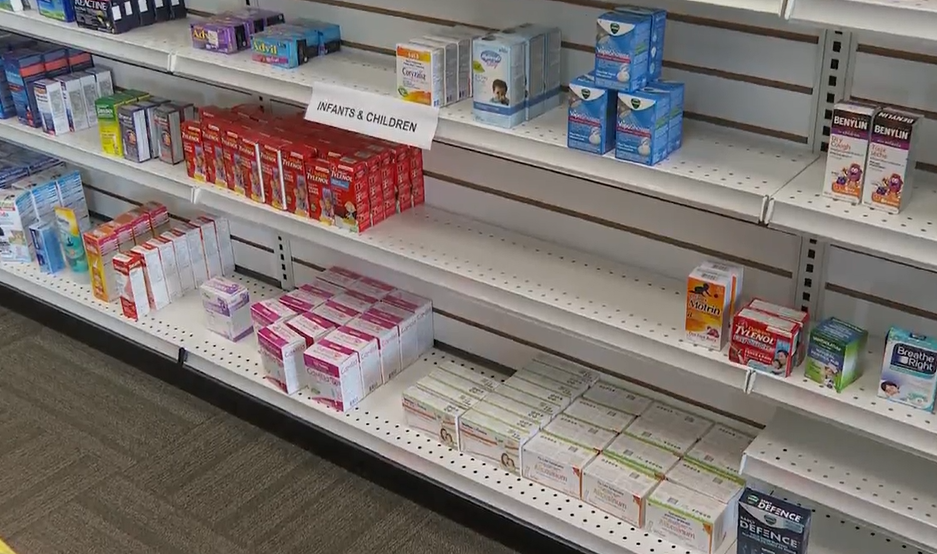Health Canada said it’s working directly with manufacturers to rectify the ongoing shortage of children’s acetaminophen and ibuprofen products.

But it warns that intermittent supply will continue to be an issue at retail locations for the time being.
“Over the summer months, there was unprecedented demand for these products and supply had not kept pace,” Health Canada said in a statement.
READ MORE: Parents, critics demand fix to kids’ pain medication shortage ahead of Canada’s flu season
“We are working hand-in-hand with manufacturers and suppliers to keep increasing supply to meet consumer demand and to ensure that parents and caregivers have access to these important products.”
Health Canada states that federal health minister Jean-Yves Duclos has personally spoken to several manufacturers including Johnson & Johnson, Haleon and PharmaScience to “reiterate the urgent need to collaborate to find immediate solutions to this shortage so that parents and caregivers can have the medicines they need to take care of their children.”
It also states that some of the manufacturers are ramping up production to record levels to make sure additional supply is available.
“Additionally, companies who supply Canada have been provided pathways to import foreign products, and we are reaching out to additional suppliers,” Health Canada said.
“While supply is increasing, we expect that products will continue to be intermittently available in retail locations. As we work to get these medicines to all who need it, children’s hospitals remain a particular area of focus for replenishment. ”
- B.C. to ban drug use in all public places in major overhaul of decriminalization
- 3 women diagnosed with HIV after ‘vampire facials’ at unlicensed U.S. spa
- Solar eclipse eye damage: More than 160 cases reported in Ontario, Quebec
- ‘Super lice’ are becoming more resistant to chemical shampoos. What to use instead
“Production just hasn’t kept up its increased demand, so we’ve seen shortages at all levels,” said Jen Belcher, a pharmacist and vice-president of strategic initiatives and member relations for the Ontario Pharmacists Association (OPA).
“We haven’t been able to reorder them from the wholesalers and manufacturers have struggled to keep up.”
Belcher said that if parents can find product, it’s important not to hoard.
“It’s having a compassion for others that are in a similar situation to yourself,” she said.
“As a response to some of the panic buying that was seen in the early days, after stories about the shortages broke, pharmacies began to keep these products behind the counter and not on the shelf,” Belcher said.
“If you go into a pharmacy and you don’t see anything on the shelf, it’s worth asking at the counter for any available inventory that’s being kept behind the counter to limit that panic buying and if they have one or two bottles they can give to your family.”
Belcher said the OPA anticipates more product will be available in the coming weeks and months. She added that medications have best before and beyond use dates and that hoarding doesn’t make sense as “a long-term strategy”.
READ MORE: Children’s medicine shortage leaving some Sask. pharmacy shelves bare
If you can’t find product, Belcher advises speaking with a pharmacist about a practice called compounding, which is taking raw ingredients to make oral liquid products as a substitute.
“There are also the adult oral tablets (plain adult Tylenol acetaminophen or Advil ibuprofen products, not combination cough and cold products or Aspirin products) that can be split or used in different combinations of split and full tablets for the correct dose by weight for your child,” Belcher said.
“If you can’t have your child swallow them whole, you can crush them up and sprinkle them onto a soft food, like a pudding or apple sauce, and have your child eat that entire food in order to get that dose.”
Belcher said you should speak with a health care provider, including a pharmacist, before doing this, though.
“What we do at the pharmacy or with your health care provider would be to calculate out the correct dose for your child based on weight, whether that be half of a regular strength tablet or one regular strength tablet or half of an extra strength, or so forth,” she said.




Comments